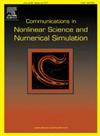Spatiotemporal dynamics in a periodic SIS epidemic model with Fokker–Planck-type diffusion
IF 3.8
2区 数学
Q1 MATHEMATICS, APPLIED
Communications in Nonlinear Science and Numerical Simulation
Pub Date : 2025-09-28
DOI:10.1016/j.cnsns.2025.109363
引用次数: 0
Abstract
To investigate the effects of seasonality and individual movement on disease transmission, we formulate a periodic SIS epidemic model with external supply governed by Fokker–Planck-type diffusion law in a spatially heterogeneous environment. A key feature of the model is the incorporation of Fokker–Planck-type diffusion to describe individual movement. We analyze the asymptotic profiles and uniform boundedness of the basic reproduction ratio with respect to the dispersal rate by addressing challenges arising from periodicity and the diffusion mechanism. Under certain conditions, explicit upper bounds for the solution are derived following the comparison principle and invariant region theory. The threshold dynamics indicate that the disease-free -periodic solution is globally asymptotically stable as and the system becomes uniformly persistent as . Numerical analysis demonstrates that increasing the dispersal of susceptible individuals can reduce the scale of infection. Furthermore, periodicity is shown to enhance disease persistence and induce greater complexity into the disease dynamics.
具有fokker - planck型扩散的周期性SIS流行病模型的时空动力学
为了研究季节性和个体运动对疾病传播的影响,我们建立了空间异质环境下具有外部供应、受fokker - planck型扩散规律支配的周期性SIS流行病模型。该模型的一个关键特征是结合了福克-普朗克型扩散来描述个体运动。通过解决周期性和扩散机制带来的挑战,我们分析了基本再生比R0关于扩散率的渐近分布和一致有界性。在一定条件下,根据比较原理和不变区域理论,导出了解的显式上界。阈值动力学表明,无病θ-周期解在R0>;1时全局渐近稳定,系统在R0>;1时一致持久。数值分析表明,增加易感个体的分散可以减小感染规模。此外,周期性被证明可以增强疾病的持久性,并引起疾病动力学的更大复杂性。
本文章由计算机程序翻译,如有差异,请以英文原文为准。
求助全文
约1分钟内获得全文
求助全文
来源期刊

Communications in Nonlinear Science and Numerical Simulation
MATHEMATICS, APPLIED-MATHEMATICS, INTERDISCIPLINARY APPLICATIONS
CiteScore
6.80
自引率
7.70%
发文量
378
审稿时长
78 days
期刊介绍:
The journal publishes original research findings on experimental observation, mathematical modeling, theoretical analysis and numerical simulation, for more accurate description, better prediction or novel application, of nonlinear phenomena in science and engineering. It offers a venue for researchers to make rapid exchange of ideas and techniques in nonlinear science and complexity.
The submission of manuscripts with cross-disciplinary approaches in nonlinear science and complexity is particularly encouraged.
Topics of interest:
Nonlinear differential or delay equations, Lie group analysis and asymptotic methods, Discontinuous systems, Fractals, Fractional calculus and dynamics, Nonlinear effects in quantum mechanics, Nonlinear stochastic processes, Experimental nonlinear science, Time-series and signal analysis, Computational methods and simulations in nonlinear science and engineering, Control of dynamical systems, Synchronization, Lyapunov analysis, High-dimensional chaos and turbulence, Chaos in Hamiltonian systems, Integrable systems and solitons, Collective behavior in many-body systems, Biological physics and networks, Nonlinear mechanical systems, Complex systems and complexity.
No length limitation for contributions is set, but only concisely written manuscripts are published. Brief papers are published on the basis of Rapid Communications. Discussions of previously published papers are welcome.
 求助内容:
求助内容: 应助结果提醒方式:
应助结果提醒方式:


